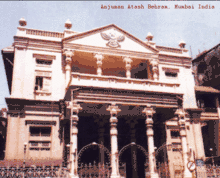Atash Behram
An Atash Behram (Fire of Victory) is the highest grade of a fire that can be placed in a (Zoroastrian) fire temple. The establishment and consecration of this fire is the most elaborate of all the grades of fire. It involves the gathering of 16 different types of fire, including lightning, fire from a cremation pyre, fire from trades where a furnace is operated, and fires from the hearths as is also the case for the Atash Adaran. Each of the 16 fires is then subject to a purification ritual before it joins the others. 32 priests are required for the consecration ceremony, which can take up to a year to complete.
Types of fire
The 16 types of fire required for an Atash Behram are:[1]
- The fire used by a dyer
- The fire from a house of a king or a ruling authority
- Fire from a potter
- Fire from a brick-maker
- From an ascetic
- Fire from a goldsmith
- Fire from a mint
- From an ironsmith
- Fire from an armourer
- From a baker,
- From a brewer
- From a soldier
- Fire from a shepherd
- Fire produced by atmospheric lightning
- Fire from the house of any Zoroastrian
List of Atash Behrams
This is a list of Atash Behrams that still survive today.
| Image | Name | Location | Year Established |
|---|---|---|---|
|
|
Iranshah Atash Behram | Udvada | 1742 |
| Desai Atash Behram | Navsari | 1765 | |
| Dadiseth Atash Behram | Mumbai | 1783 | |
| Vakil Atash Behram | Surat | 1823 | |
| Modi Atash Behram | Surat | 1823 | |
| Wadia Atash Behram | Mumbai | 1830 | |
| Banaji Atash Behram | Mumbai | 1845 | |
|
|
Anjuman Atash Behram | Mumbai | 1897 |
 |
Yezd Atash Behram | Yazd | 1932 |
References
This article is issued from
Wikipedia.
The text is licensed under Creative Commons - Attribution - Sharealike.
Additional terms may apply for the media files.

